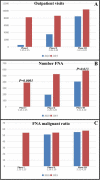Thyroid surgery during coronavirus-19 pandemic phases I, II and III: lessons learned in China, South Korea, Iran and Italy
- PMID: 32876925
- PMCID: PMC7463102
- DOI: 10.1007/s40618-020-01407-1
Thyroid surgery during coronavirus-19 pandemic phases I, II and III: lessons learned in China, South Korea, Iran and Italy
Abstract
Objective: We compared demographic and clinic-pathological variables related to the number of surgeries for thyroid conditions or for cancer, morbidity, and fine needle aspiration (FNA) practices among Covid19 pandemic phases I, II, III and the same seasonal periods in 2019.
Methods: The prospective database of the Division of Thyroid Surgery, China-Japan Union Hospital of Jilin University, Changchun, China was used for this study. Covid19 emergency levels were stratified according to the World Health Organization: phase I (January 25-February 25, 2020), phase II (February 26-March 19), phase III (March 20-April 20).
Results: There were fewer outpatient FNAs and surgeries in 2020 than in 2019. There were no thyroid surgeries during phase I. There were also fewer surgeries for cancer with a significant reduction of advanced stage cancer treatments, mainly stage T1b N1a in phase II and T3bN1b in phase III. Operative times and postoperative stays were significantly shorter during the pandemic compared to our institutional baseline. In phase III, vocal cord paralysis (VCP) increased to 4.3% of our baseline numbers (P = 0.001). There were no cases of Covid19-related complications during the perioperative period. No patients required re-admission to the hospital.
Conclusion: The Covid19 outbreak reduced thyroid surgery patient volumes. The decrease of Covid19 emergency plans contributed to unexpected outcomes (reduction of early stage cancer treatment, decreased operative times and hospital stays, increased VCP rate).
Keywords: Cancer; China; Covid19; Iran; Italy; Morbidity; Recurrent laryngeal nerve palsy; SARS-CoV-2; South Korea; Surgery; Surgical practice; Thyroid; Thyroidectomy.
Conflict of interest statement
All Authors report having no relationships that could be construed as a conflict of interest.
Figures

References
-
- Society of American Gastrointestinal and Endoscopic Surgeons (SAGES) (2020) SAGES AND EAES recommendations regarding surgical response to COVID-19 crisis [Internet]. Los Angeles (CA): Society of American Gastrointestinal and Endoscopic Surgeons. https://www.sages.org/recommendations-surgical-response-covid-19/. Cited 30 Apr 2020
-
- Li Q, Guan X, Wu P, Wang X, Zhou L, Tong Y, Ren R, Leung KSM, Lau EHY, Wong JY, Xing X, Xiang N, Wu Y, Li C, Chen Q, Li D, Liu T, Zhao J, Liu M, Tu W, Chen C, Jin L, Yang R, Wang Q, Zhou S, Wang R, Liu H, Luo Y, Liu Y, Shao G, Li H, Tao Z, Yang Y, Deng Z, Liu B, Ma Z, Zhang Y, Shi G, Lam TTY, Wu JT, Gao GF, Cowling BJ, Yang B, Leung GM, Feng Z. Early transmission dynamics in Wuhan, China, of novel coronavirus-infected pneumonia. N Engl J Med. 2020;382(13):1199–1207. doi: 10.1056/NEJMoa2001316. - DOI - PMC - PubMed
-
- Zhu N, Zhang D, Wang W, Li X, Yang B, Song J, Zhao X, Huang B, Shi W, Lu R, Niu P, Zhan F, Ma X, Wang D, Xu W, Wu G, Gao GF, Tan W, China Novel Coronavirus Investigating and Research Team A novel coronavirus from patients with pneumonia in China, 2019. N Engl J Med. 2020;382(8):727–733. doi: 10.1056/NEJMoa2001017. - DOI - PMC - PubMed
MeSH terms
Grants and funding
LinkOut - more resources
Full Text Sources
Medical
Miscellaneous

